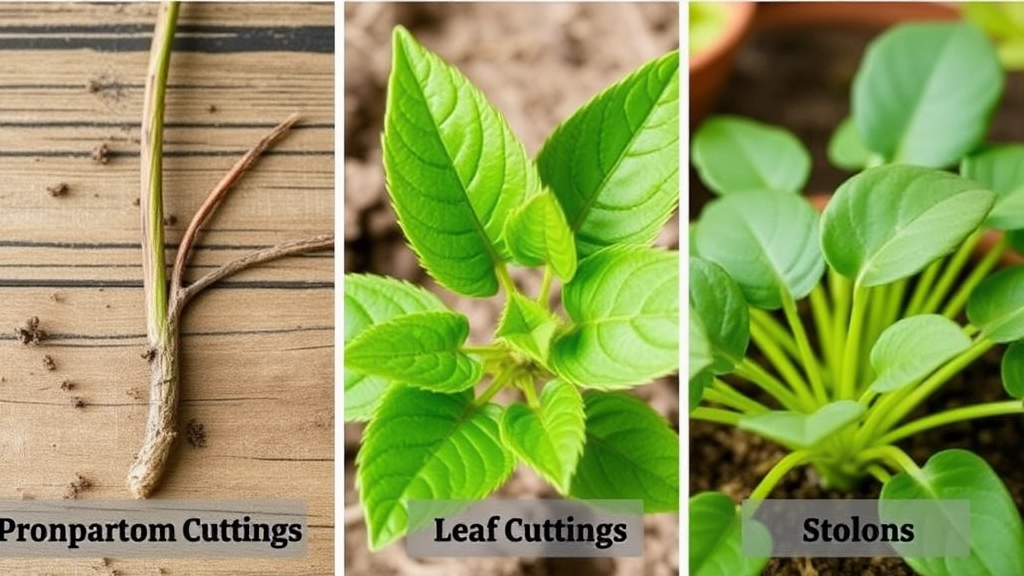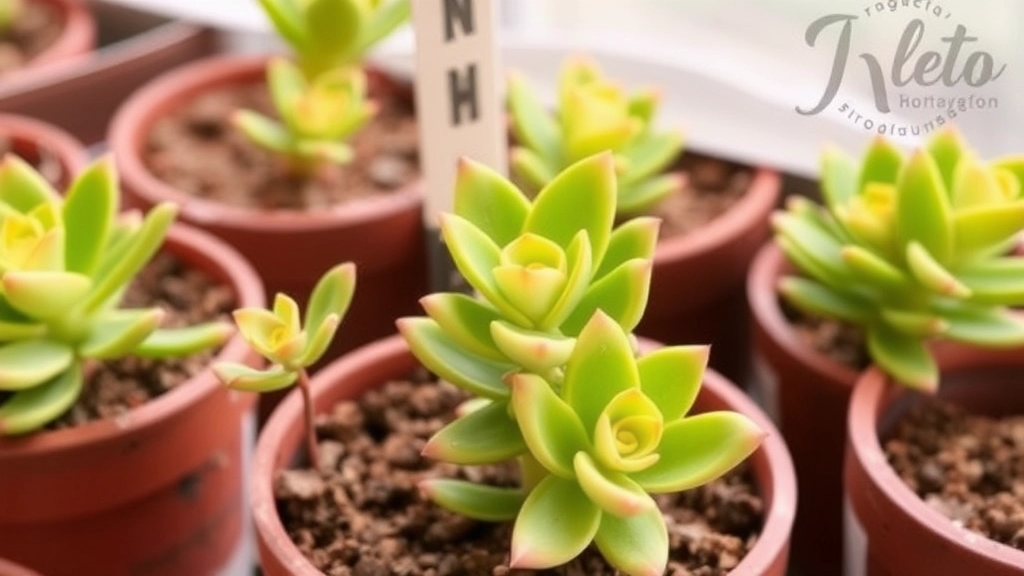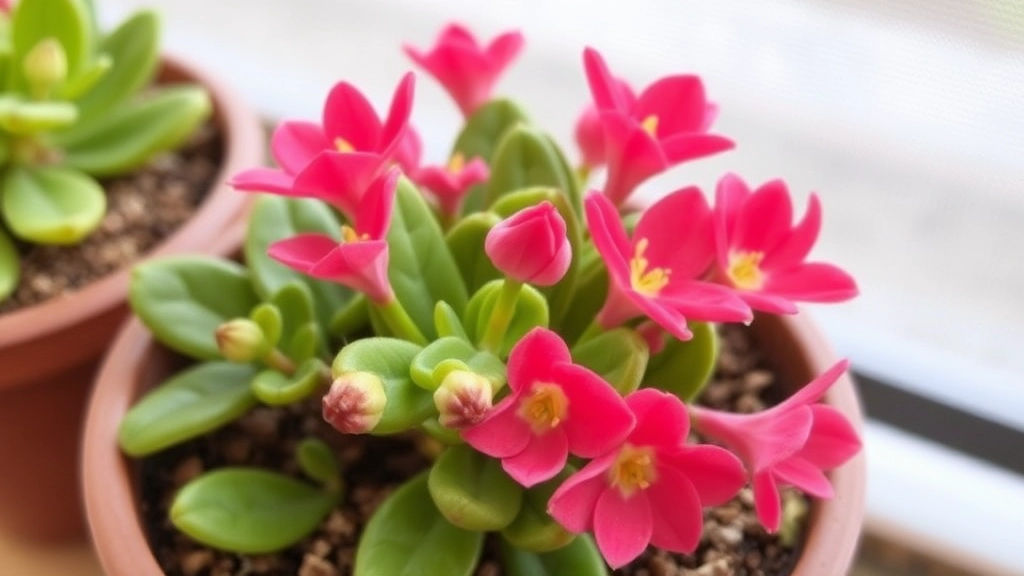Kalanchoe Synsepala Propagation
If you’re curious about Kalanchoe synsepala propagation, you’re in the right place. This unique succulent, also known as the “Walking Kalanchoe,” can be propagated through various methods such as stem cuttings, leaf cuttings, and stolons. The best time to propagate is during the growing season when the plant is most active. Ensuring the right soil type, proper lighting, and a consistent watering schedule will set you up for success.
Step-by-Step Process
Let’s dive into the step-by-step process. Start by selecting a healthy stem or leaf to cut. For stolon-based propagation, gently remove a stolon and plant it in well-draining soil. Keep the cuttings in a warm, bright spot but out of direct sunlight, and water sparingly until roots form.
Common Mistakes to Avoid
- Overwatering
- Using poor soil
With a bit of care, your new Kalanchoe synsepala plants will thrive.
When considering the propagation of Kalanchoe Synsepala, many enthusiasts often wonder about the ideal time and conditions to achieve successful results.
The best time to propagate Kalanchoe Synsepala is during the spring or early summer. This period aligns with the plant’s natural growth cycle, providing optimal conditions for rooting.
Key Conditions for Successful Propagation:
– **Temperature:** Aim for a warm environment, ideally between 20°C to 25°C. This warmth encourages faster root development.
– **Light:** Provide bright, indirect sunlight. Direct sunlight can scorch the cuttings, while too little light can hinder growth.
– **Humidity:** A moderate humidity level is beneficial. If the air is too dry, consider using a humidity dome or misting the cuttings occasionally.
– **Soil:** Use a well-draining soil mix, such as a cactus or succulent blend. This prevents waterlogging, which can lead to rot.
By ensuring these conditions, you set the stage for healthy propagation. For more detailed care tips, you might find the [complete guide for Kalanchoe Synsepala](https://planthq.org/kalanchoe-synsepala-care-complete-guide-for-healthy-growth/) useful. Additionally, understanding the [ideal temperature for Kalanchoe growth](https://planthq.org/ideal-temperature-for-kalanchoe-blossfeldiana-growth/) can further enhance your propagation success.
Propagation Methods: Stem Cuttings, Leaf Cuttings, and Stolons

So, you’re ready to dive into propagating your Kalanchoe Synsepala, but how do you actually do it?
There are a few straightforward methods you can use: stem cuttings, leaf cuttings, and stolons. Each has its perks, and I’m here to break them down for you.
1. Stem Cuttings
This is probably the most popular method. Here’s how you can do it:
- Choose a healthy stem: Look for a stem that’s firm and free of any blemishes.
- Cut it right: Use clean, sharp scissors to snip a few inches off the stem, ideally just below a leaf node.
- Let it callous: Place the cutting in a dry, warm spot for a couple of days. This helps it form a callous, which reduces the risk of rot.
2. Leaf Cuttings
Leaf cuttings are another great option, especially if you don’t want to chop off a whole stem. Here’s the scoop:
- Select a plump leaf: Pick a healthy, thick leaf from your plant.
- Cut it carefully: Use your scissors to slice the leaf into sections, each about 2-3 inches long. Make sure each section has a vein; that’s where the magic happens!
- Dry it out: Just like with stem cuttings, let the leaf sections sit out for a day or two to callous over.
3. Stolons
If your Kalanchoe Synsepala has produced stolons (those little runners), you’re in luck! Here’s what to do:
- Identify the stolons: Look for the small, vine-like stems that sprout from the base of the plant.
- Snip them off: Cut the stolons with a bit of the parent plant attached.
- Plant them directly: You can place the stolons in soil right away, and they should root quickly.
Each of these methods can yield beautiful new plants, but remember to choose the one that works best for you and your gardening style.
Preparing and Caring for Cuttings During Rooting
Once you’ve gathered your cuttings, the next step is to ensure they are well-prepared for rooting.
Are you worried about whether your cuttings will thrive? Understanding the right conditions and care can make all the difference.
Preparing Your Cuttings
- Choose Healthy Cuttings:
- Select robust stems or leaves with no signs of disease.
- Aim for cuttings that are at least 10 cm long for optimal growth.
- Let Them Callous:
- Place the cuttings in a dry, shaded area for a few hours or overnight.
- This allows the cut ends to callous, reducing the risk of rot when placed in soil.
- Use the Right Soil:
- A well-draining mix is crucial. Consider using a cactus or succulent potting mix.
- You can also create your own mix by combining regular potting soil with perlite or sand.
- For more details, check out the best soil for Kalanchoe Blossfeldiana care tips.
Caring for Your Cuttings
- Water Sparingly:
- After planting, lightly mist the soil to provide moisture without waterlogging.
- Allow the soil to dry out completely between waterings.
- Provide Indirect Light:
- Position your cuttings in a spot with bright, indirect sunlight.
- Avoid direct sunlight, as it can scorch the delicate cuttings.
- Maintain Humidity:
- To encourage rooting, you can cover the cuttings with a plastic bag or a clear plastic dome.
- Ensure there is some ventilation to prevent mould growth.
- Monitor Temperature:
- Keep the environment warm, ideally between 20-25°C.
- A consistent temperature encourages faster root development.
For more in-depth information on propagating Kalanchoe, visit our guide on how to propagate Kalanchoe Blossfeldiana cuttings.
Common Mistakes to Avoid in Kalanchoe Synsepala Propagation

As you embark on your journey to propagate Kalanchoe Synsepala, it’s essential to be aware of common pitfalls that can hinder your success. Avoiding these mistakes will ensure your cuttings thrive and grow into healthy plants.
1. Using Inappropriate Soil
Choosing the wrong soil can lead to poor drainage and root rot.
- Tip: Use a well-draining cactus or succulent mix to promote healthy root development.
2. Overwatering
One of the most frequent mistakes is overwatering the cuttings.
- Tip: Allow the soil to dry out between waterings. A good rule of thumb is to water only when the top inch of soil feels dry.
3. Neglecting Light Requirements
Insufficient light can cause your cuttings to become leggy and weak.
- Tip: Place your cuttings in a bright, indirect light location. Avoid direct sunlight, which can scorch the leaves.
4. Not Allowing Cuttings to Callus
Failing to let your cuttings callus before planting can lead to rot.
- Tip: Allow cuttings to sit in a dry, shaded area for a few days until the cut ends form a protective callus.
5. Ignoring Temperature Conditions
Extreme temperatures can stress your cuttings.
- Tip: Maintain a warm environment, ideally between 20-25°C (68-77°F), to encourage rooting.
6. Using Old or Unhealthy Cuttings
Starting with weak or diseased cuttings can set you up for failure.
- Tip: Always select healthy, vigorous cuttings from mature plants.
After successfully propagating your Kalanchoe Synsepala, you may wonder how to ensure they thrive in the long run. Proper long-term care is crucial for the health and vitality of your plants.
**Watering**
– **Frequency**: Allow the soil to dry out between waterings. Overwatering can lead to root rot, a common issue with succulents.
– **Method**: Water thoroughly until it drains from the bottom. This encourages deep root growth.
**Light Requirements**
– **Location**: Place your Kalanchoe Synsepala in a bright, indirect light spot. Direct sunlight can scorch the leaves.
– **Rotation**: Rotate the pot every few weeks to ensure even growth and prevent leaning.
**Soil and Fertilisation**
– **Soil Type**: Use a well-draining cactus or succulent mix. This helps prevent water retention.
– **Fertiliser**: During the growing season (spring and summer), feed with a diluted succulent fertiliser every 4-6 weeks. Avoid fertilising in autumn and winter.
**Pruning and Maintenance**
– **Pruning**: Remove any dead or yellowing leaves to promote healthy growth and prevent pests. For more detailed tips, you can refer to our guide on [pruning Kalanchoe plants](https://planthq.org/pruning-kalanchoe-plants-best-tips-and-techniques/).
– **Pest Control**: Regularly check for pests like mealybugs or aphids. If spotted, treat with insecticidal soap or neem oil.
**Repotting**
– **Timing**: Repot every couple of years or when you notice roots growing out of the drainage holes. For a comprehensive care routine, visit our [complete guide for Kalanchoe Beharensis](https://planthq.org/complete-care-guide-for-kalanchoe-beharensis-felt-plant/).
– **Size**: Choose a pot that is one size larger to allow for growth.
FAQs on Kalanchoe Synsepala Propagation
What are the primary methods for propagating Kalanchoe Synsepala?
There are three main methods for propagating Kalanchoe Synsepala: stem cuttings, leaf cuttings, and stolons. Each method has its own advantages and can be chosen based on your preference and the condition of your plant.
How do I propagate Kalanchoe Synsepala using stem cuttings?
To propagate using stem cuttings, follow these steps:
- Choose a healthy stem: Look for a firm, blemish-free stem.
- Cut it right: Use clean, sharp scissors to snip a few inches off the stem, ideally just below a leaf node.
- Let it callous: Place the cutting in a dry, warm spot for a couple of days to form a callous and reduce the risk of rot.
Can I propagate Kalanchoe Synsepala from leaf cuttings?
Yes, leaf cuttings are another effective method. Here’s how:
- Select a plump leaf: Pick a healthy, thick leaf from your plant.
- Cut it carefully: Slice the leaf into sections, each about 2-3 inches long, ensuring each section has a vein.
- Dry it out: Let the leaf sections sit out for a day or two to callous over.
What are stolons, and how do I use them for propagation?
Stolons are small, vine-like stems that sprout from the base of the plant. To propagate using stolons:
- Identify the stolons: Look for the small, vine-like stems.
- Snip them off: Cut the stolons with a bit of the parent plant attached.
- Plant them directly: Place the stolons in soil right away, and they should root quickly.
What type of soil should I use for Kalanchoe Synsepala cuttings?
Using inappropriate soil can lead to poor drainage and root rot. It’s best to use a well-draining cactus or succulent mix to promote healthy root development.
How often should I water my Kalanchoe Synsepala cuttings?
Overwatering is a common mistake. Allow the soil to dry out between waterings. Water only when the top inch of soil feels dry to the touch.
What light conditions are best for propagating Kalanchoe Synsepala?
Place your cuttings in a bright, indirect light location. Avoid direct sunlight, which can scorch the leaves.
Why is it important to let cuttings callous before planting?
Allowing cuttings to callous before planting helps prevent rot. Let the cuttings sit in a dry, shaded area for a few days until the cut ends form a protective callus.
What temperature conditions are ideal for Kalanchoe Synsepala cuttings?
Maintain a warm environment, ideally between 20-25°C (68-77°F), to encourage rooting and reduce stress on the cuttings.
How can I ensure I’m using healthy cuttings for propagation?
Always select healthy, vigorous cuttings from mature plants. Starting with weak or diseased cuttings can decrease your chances of successful propagation.
